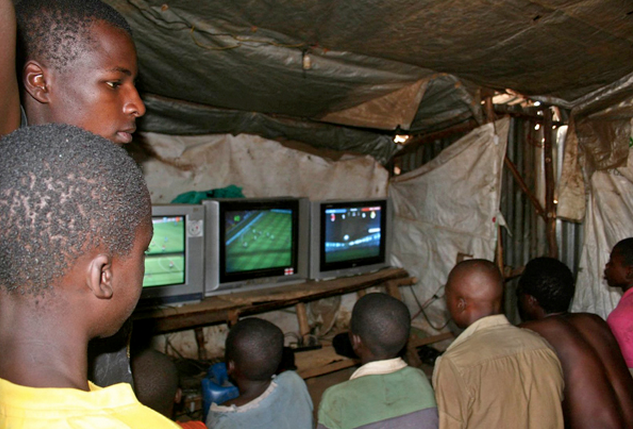This guest post is by journalist Abby Higgins, in partnership with The Seattle Globalist. It’s the second in a four part series which reveals the economically complex and culturally rich life of urban slums, and challenges our perceptions of what life is like for the 1 billion people around the world that live in them. Read Abby’s first post.
The shop is dark and humid. I duck inside, and the warm glow of three television screens coats a room filled with a dozen neighborhood boys. Three of them hammer away at PlayStation controllers, sending a tiny soccer ball leaping across the screen.
“They pay 10 shilling to play for 10 minutes,” explains Vitalis Odhiambo, the shop owner. “I probably get around 20 customers in a day, more when school is out of session.”

Neighbourhood youth pay about ten cents for ten minutes of play on PlayStation consoles in Diddy’s arcade. (Photo by Abby Higgins)
Odhiambo, who goes by the nickname Diddy, was born in Kibera and has lived there his entire life. In addition to his PlayStation business, he runs a shop outside of Kibera that sells women’s shoes and clothing. He even operates a tour company, capitalising on outsiders’ curiosity about his increasingly famous home.
Like most slums, Kibera has no formal government services. Residents can’t access clean water, sanitation, electricity or health care the way the rest of Nairobi does.
It’s easy to think of slums as places of listless poverty filled with victims of circumstances waiting for outside intervention. But Odhiambo’s shop shows another side. Slum dwellers are entrepreneurs and innovators, constantly manipulating their surroundings to creatively address the problems they and their communities face.
“They’re probably the most inventive people in the world because they often have limited access to resources,” said Cynthia Smith, who is the curator of socially responsible design at the Smithsonian Cooper-Hewitt National Design Museum.
Smith traveled to 15 countries to learn about slum innovations, from vertical water and sewer services climbing a mountainside settlement in Caracas, Venezuela, to a community oven in Kibera that uses rubbish as fuel. She has compiled her work into an ongoing exhibition called “Design with the Other 90%: CITIES.”
According to U.N. Habitat, 85% of new employment opportunities around the world are in the informal economy, like the untaxed, unregulated businesses in Kibera.
If he gets a little more start-up capital, Diddy says, he’ll expand his business to build a larger gaming centre, with computers and additional PlayStation consoles. But isn’t it difficult to operate a video arcade with no formal electrical system?
Odhiambo says it’s rarely a problem. His shop is powered by Kibera’s primary electricity suppliers, a complex — and entirely illegal — system that has been maintained by generations of Kibera residents.

Not connected to the formal utilities of Nairobi, Kibera residents build everything themselves from power lines to water cisterns. (Photo by Alex Stonehill)
Phillip, who asked that his last name not be used because of the illegal nature of his work, is one of dozens of agents who keep the slum powered. Residents pay him about $4 per month to get hooked up.
He grew up in Kibera and is using his job as an informal electricity broker to pay his college tuition while he is studying broadcast journalism.
“We run three lines from different parts of the city. That way if one isn’t working, there are two additional lines that can be used as backup,” Philip told me. “It’s very infrequent that people lose their power.”
On the whole, Nairobi is a highly developed, modern city. Just ten minutes from Kibera are luxury apartments and malls with boutique stores and sushi restaurants. But even wealthy neighbourhoods like Lavington and Karen — home to former Prime Minister Raila Odinga — have basic infrastructure problems that are unfamiliar in the global north. Last year, I spent an entire night with my electronics piled around me at a dingy restaurant because I had a deadline to meet and it was the only place in my neighbourhood with electricity.
I asked Phillip if it was possible that Kibera’s residents enjoyed more reliable power than I did. “I’d say that is probably true,” he answered with a smile.
Check back next week for Part Three



